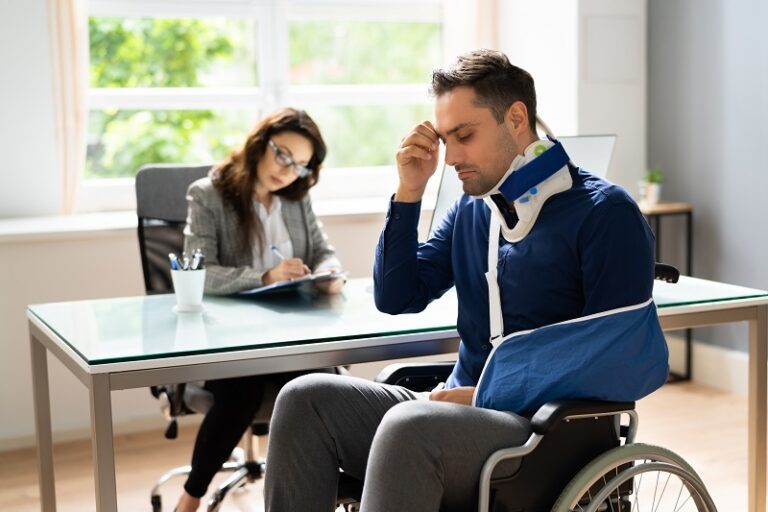
In everyday life, and especially in encounters with law-related topics, you have probably heard someone use the phrase “demonstrable evidence.” Typically, it may have come up in a statement that went something like: “If you want me to believe [X], you’re going to have to show me demonstrable evidence that [Y].”
Most people have a general idea of what demonstrable evidence means. It refers, essentially, to information or items that a person can see, hear, touch, and (most importantly) trust as proof of a fact.
For a parent, demonstrable evidence that their child took out the garbage is seeing trash cans at the end of the driveway. For a teacher, students’ rising test scores constitute demonstrable evidence that a lesson plan works. For a shopkeeper, inventory going missing from display tables near the door is demonstrable evidence of a shoplifting problem.
But what about lawyers, judges, and other legal professionals? What does demonstrable evidence mean to them?
That is what we set out to explore in this blog post. It covers the significance of demonstrable evidence in legal settings, what constitutes demonstrable evidence in a personal injury case, and how you may even help your lawyer assemble demonstrable evidence to prove your case for damages.
[lwptoc]
Demonstrable Evidence in the Law
For attorneys and others who ply their trade in the legal profession, demonstrable evidence has a slightly more specific and technical meaning.
In the law, demonstrable evidence is any information you may use to prove a particular fact. To put it a little less technically, demonstrable evidence, for a lawyer, means pretty much what it means in everyday speech, but with the added complication that laws, regulations, court decisions, and other legal authorities decide when evidence is reliable and relevant enough to use.
Here’s an illustration. In everyday life, you might treat a parking ticket on your windshield as “demonstrable evidence” that you broke a parking law. That is, if someone were to ask you, “How do you know you were parked illegally?” you might answer, “Because I got a ticket.”
In a courtroom, however, that same ticket would not constitute demonstrable evidence of your parking violation. It would only show that a police officer believed you broke a parking rule.
Demonstrable evidence of your actual parking violation, for a lawyer and a judge, would instead consist of the underlying information that allowed the officer to conclude that you parked illegally—a picture of your car parked in front of a fire hydrant, for example, or the officer’s testimony about seeing that your parking meter had expired.
Demonstrable evidence is often also “admissible” evidence. Evidence is admissible when it’s demonstrable and meets the strict requirements to include in a trial or other judicial proceeding, as in the example above.
But evidence can be demonstrable even if it’s not admissible in a trial. Hearsay (an out-of-court statement offered as proof of what the statement says), for example, generally can’t prove a fact in a trial. But courts routinely accept hearsay as demonstrable evidence of a fact in non-trial proceedings.
So, to recap, demonstrable evidence, for lawyers, is evidence the law allows them to use to prove a fact in a specific legal setting. Now, let’s turn to what constitutes demonstrable evidence in a personal injury case.
Demonstrable Evidence in a Personal Injury Case
In a personal injury case, a lawyer for the injured party (known as the plaintiff) needs demonstrable evidence to prove:
- That someone’s unreasonable, wrongful conduct caused the plaintiff’s injuries (making them legally liable for those injuries); and
- That the plaintiff suffered damages that a financial award or another legally authorized remedy can compensate.
The lawyer may also need demonstrable evidence to prove other facts, depending on the specifics of the given case. But those two core facts are virtually always essential for the lawyer to get money for an injured client.
Here is some demonstrable evidence a lawyer might use to prove those two core facts.
Demonstrable Evidence of Liability
Demonstrable evidence of liability consists of any evidence that reliably and appropriately helps the lawyer prove what happened to the plaintiff and who they should blame for it.
Take, for example, a freeway car accident that the plaintiff’s lawyer wants to prove a motorist caused while texting and driving.
Demonstrable evidence of the distracted driver’s liability may consist of:
- The plaintiff’s, distracted driver’s, and other eyewitness testimony about how the accident happened or what the distracted driver said about it;
- Video and photographic evidence of the accident, accident scene, and vehicles;
- Data from the vehicles’ on-board computers;
- Data from the distracted driver’s telephone;
- The distracted driver’s driving record; and
- Testimony and exhibits from an accident reconstruction expert.
These are just some examples, of course. Every personal injury case is unique. The lawyer’s challenge in each one is to determine the type of evidence that would most effectively prove what happened and who is to blame for a client’s injuries and gather as much of that evidence as possible.
That’s not always an easy task, but the sooner an injured individual seeks the help of a skilled personal injury lawyer, the better the lawyer’s chances of collecting the demonstrable evidence of liability necessary to prove the plaintiff’s case.
Demonstrable Evidence of Damages
By the same token, demonstrable evidence of the plaintiff’s damages seeks to show all of the ways an injury has impacted a plaintiff’s life, be it physically, emotionally, or financially.
Demonstrable evidence of damages may include:
- The plaintiff’s, and plaintiff’s doctor’s, testimony about the plaintiff’s injuries and prognosis, and their impact on the plaintiff’s daily life;
- The plaintiff’s medical records;
- Bills, receipts, and other documentation of the expenses the plaintiff has incurred;
- Pay stubs, earnings records, and other documentation of the plaintiff’s lost income due to the injuries;
- Testimony from the plaintiff’s family and friends about the impact of an injury on the plaintiff’s life and relationships; and
- Expert testimony from experts about the plaintiff’s future financial and medical needs.
Skilled personal injury lawyers often work closely with their clients and clients’ loved ones to gather evidence that paints the fullest picture possible of the harm their clients have suffered. Every item of solid, demonstrable evidence of damages they uncover can add to the amount of money the client has a claim to receive.
Tips for Preserving Demonstrable Evidence of Liability and Damages
If you suffered injuries because of someone else’s wrongdoing, you may have the right to financial compensation. To help ensure you get the full benefit of those rights, contact a skilled personal injury attorney as soon as possible after getting hurt. The sooner you have an attorney on your side, the better your chances of securing the maximum compensation available.
In addition, you may be able to help your attorney gather the demonstrable evidence of liability and damages you will need by following these tips.
Save Everything
The first tip for preserving demonstrable evidence of someone’s liability to you for your damages is to save everything in your possession that relates in any way to the accident that harmed you, and the injuries you suffered.
Everything means… everything.
You should save:
- All bills, receipts, statements, pay stubs, and other documents of any kind, paper or electronic, that show the money you spent or missed out on earning because of your injuries. Each of these pieces of paper constitutes an item of evidence of your damages.
- All physical items tied in any way to the accident that caused your injury, including the clothes you were wearing when you got hurt (don’t wash or mend them) and items of damaged personal property you carried.
- The damaged vehicle (car, truck, motorcycle, bicycle, etc.) you were riding in or on—do not get anything repaired until your attorney’s team has had an opportunity to inspect and photograph it.
- In a case involving a defective product, the tool, implement, or consumer item that harmed you.
The bottom line is that every single item you have that relates to your accident or injury could constitute key demonstrable evidence to prove your case. Do not throw anything fitting that description away until your attorney has had the chance to evaluate it.
Gather What You Can
In addition to potential demonstrable evidence already in your possession, you may also take reasonable steps to gather other evidence of what happened, who should bear the blame, and the extent of your damages.
That evidence could include, for example:
- Police accident reports and other official reports of what happened;
- Photographs or videos of the scene of the accident that caused your injuries;
- Names and contact information for anyone who witnessed the accident;
- Medical records of your treatment.
If you can’t gather this information, that’s okay. Skilled personal injury lawyers know how to locate and collect this information on your behalf.
But only if you call them. And the sooner the better. Demonstrable evidence of liability and damages becomes increasingly difficult to find and secure with time.
A seasoned personal injury attorney can frequently find evidence long after critical events take place, but chances are best of finding the greatest quantity and highest quality of evidence in the days and weeks after an injury occurs.
Find a Lawyer You Feel Comfortable Talking To
Developing a body of demonstrable evidence showing liability and damages requires a lawyer to know the facts of your case in detail. That often means spending a lot of time with you and your loved ones, learning about the impact of an injury on your everyday life, relationships, and hopes for the future.
Those can be emotional conversations. So, it helps to have a lawyer who you feel you can trust, and with whom you are comfortable sharing the medical, financial, and personal information that you wouldn’t normally talk about with just anyone.
In the same vein, the best personal injury lawyers can “listen to learn,” not just “listen to respond.” When interviewing potential attorneys to represent you in your personal injury case, look for the attorneys who can connect with you and hear what you have to say, and avoid those who just seem to be waiting until you finish answering a question so that they can hear themselves talk.
How do you find that lawyer? You can start by having a free consultation. Personal injury lawyers offer these consultations as a way for lawyers and potential clients to get to know each other and to conduct a preliminary evaluation of a case. Because consultations are free and come with no obligation on anyone’s part to move forward, you can use them as a way to interview your potential lawyer and get a feel for whether it’s a good fit for both of you.
Time isn’t on your side. Interviewing and hiring a lawyer as soon as possible gives you and the lawyer the best opportunity to collect demonstrable evidence of liability and damages to support your case. It also protects you against missing important deadlines for taking legal action. And it gives you the peace of mind of knowing that you have a team of legal professionals working to advance your interests.
Want to know more about the types of demonstrable evidence a lawyer may need to prove your case for damages? Contact a skilled personal injury attorney today for your free case consultation.







